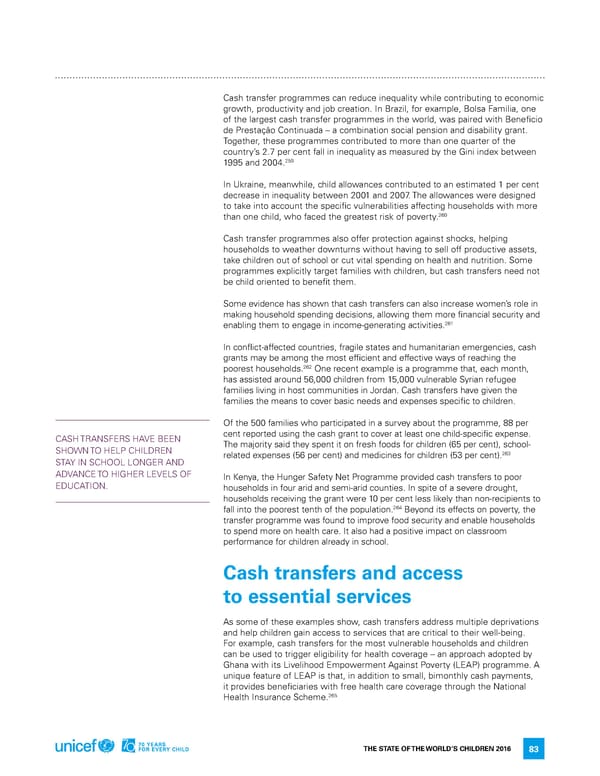Cash transfer programmes can reduce inequality while contributing to economic growth, productivity and job creation. in Brazil, for example, Bolsa familia, one of the largest cash transfer programmes in the world, was paired with Beneficio de Prestação Continuada – a combination social pension and disability grant. Together, these programmes contributed to more than one quarter of the country’s 2.7 per cent fall in inequality as measured by the Gini index between 259 1995 and 2004. in Ukraine, meanwhile, child allowances contributed to an estimated 1 per cent decrease in inequality between 2001 and 2007. The allowances were designed to take into account the specific vulnerabilities affecting households with more 260 than one child, who faced the greatest risk of poverty. Cash transfer programmes also offer protection against shocks, helping households to weather downturns without having to sell off productive assets, take children out of school or cut vital spending on health and nutrition. Some programmes explicitly target families with children, but cash transfers need not be child oriented to benefit them. Some evidence has shown that cash transfers can also increase women’s role in making household spending decisions, allowing them more financial security and 261 enabling them to engage in income-generating activities. in conflict-affected countries, fragile states and humanitarian emergencies, cash grants may be among the most efficient and effective ways of reaching the 262 poorest households. one recent example is a programme that, each month, has assisted around 56,000 children from 15,000 vulnerable Syrian refugee families living in host communities in Jordan. Cash transfers have given the families the means to cover basic needs and expenses specific to children. of the 500 families who participated in a survey about the programme, 88 per CaSh TranSferS haVe Been cent reported using the cash grant to cover at least one child-specific expense. ShoWn To helP Children The majority said they spent it on fresh foods for children (65 per cent), school- related expenses (56 per cent) and medicines for children (53 per cent).263 STaY in SChool lonGer and adVanCe To hiGher leVelS of in Kenya, the hunger Safety net Programme provided cash transfers to poor edUCaTion. households in four arid and semi-arid counties. in spite of a severe drought, households receiving the grant were 10 per cent less likely than non-recipients to 264 fall into the poorest tenth of the population. Beyond its effects on poverty, the transfer programme was found to improve food security and enable households to spend more on health care. it also had a positive impact on classroom performance for children already in school. Cash transfers and access to essential services as some of these examples show, cash transfers address multiple deprivations and help children gain access to services that are critical to their well-being. for example, cash transfers for the most vulnerable households and children can be used to trigger eligibility for health coverage – an approach adopted by Ghana with its livelihood empowerment against Poverty (leaP) programme. a unique feature of leaP is that, in addition to small, bimonthly cash payments, it provides beneficiaries with free health care coverage through the national 265 health insurance Scheme. The STaTe of The World’S Children 2016 83
 70 Years for Every Child Page 99 Page 101
70 Years for Every Child Page 99 Page 101